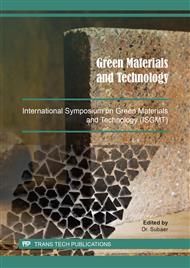[1]
T. J. Walker. House cricket, Acheta domesticus. 2007 October 2017; Information on http://entomology.ifas.ufl.edu/creatures/misc/crickets/adomest.html.
Google Scholar
[2]
C. Kipkoech, J. N. Kinyuru, S. Imathiu, and N. Roos, Use of house cricket to address food security in Kenya: Nutrient and chitin composition of farmed crickets as influenced by age, African J. Agricultural Research. 12(44) (2017) 3189-3197.
DOI: 10.5897/ajar2017.12687
Google Scholar
[3]
R. G. Harrison and S. M. Bogdanowicz, Mitochondrial DNA phylogeny of North American field crickets: perspectives on the evolution of life cycles, songs, and habitat associations, J. Evolutionary Biology. 8(2) (1995) 209-232.
DOI: 10.1046/j.1420-9101.1995.8020209.x
Google Scholar
[4]
T. Suzuki, A. Nagao, and T. Suzuki, Human mitochondrial tRNAs: biogenesis, function, structural aspects, and diseases, Annual Review of Genetics. 45 (2011) 299-329.
DOI: 10.1146/annurev-genet-110410-132531
Google Scholar
[5]
G. S. Shadel, Expression and maintenance of mitochondrial DNA: new insights into human disease pathology, The American J. Pathology. 172(6) (2008) 1445-1456.
DOI: 10.2353/ajpath.2008.071163
Google Scholar
[6]
R. DeSalle, B. Schierwater, and H. Hadrys, MtDNA: The small workhorse of evolutionary studies, Front Biosci (Landmark Ed). 22 (2017) 873-87.
DOI: 10.2741/4522
Google Scholar
[7]
A. Linderholm, Ancient DNA: the next generation–chapter and verse, Biological J. Linnean Soc. 117(1) (2015) 150-160.
DOI: 10.1111/bij.12616
Google Scholar
[8]
L.-S. Dai, B.-J. Zhu, Y. Zhao, C.-F. Zhang, and C.-L. Liu, Comparative mitochondrial genome analysis of Eligma narcissus and other lepidopteran insects reveals conserved mitochondrial genome organization and phylogenetic relationships, Scientific Reports. 6 (2016) 26387.
DOI: 10.1038/srep26387
Google Scholar
[9]
S. L. Cameron, C. L. Lambkin, S. C. Barker, and M. F. Whiting, A mitochondrial genome phylogeny of Diptera: whole genome sequence data accurately resolve relationships over broad timescales with high precision, Systematic Entomology. 32(1) (2007) 40-59.
DOI: 10.1111/j.1365-3113.2006.00355.x
Google Scholar
[10]
A. Carapelli, P. Liò, F. Nardi, E. Van der Wath, and F. Frati, Phylogenetic analysis of mitochondrial protein coding genes confirms the reciprocal paraphyly of Hexapoda and Crustacea, BMC Evolutionary Biology. 7(2) (2007) S8.
DOI: 10.1186/1471-2148-7-s2-s8
Google Scholar
[11]
J. B. Stewart and A. T. Beckenbach, Phylogenetic and genomic analysis of the complete mitochondrial DNA sequence of the spotted asparagus beetle Crioceris duodecimpunctata, Molecular Phylogenetics & Evolution. 26(3) (2003) 513-526.
DOI: 10.1016/s1055-7903(02)00421-9
Google Scholar
[12]
S. Zheng, Y. Li, X. Yang, J. Chen, J. Hua, and Y. Gao, DNA barcoding identification of Pseudococcidae (Hemiptera: Coccoidea) using the mitochondrial COI gene, Mitochondrial DNA Part B. 3(1) (2018) 419-423.
DOI: 10.1080/23802359.2018.1457988
Google Scholar
[13]
Y. Kumazawa and M. Nishida, Sequence evolution of mitochondrial tRNA genes and deep-branch animal phylogenetics, J. Molecular Evolution. 37(4) (1993) 380-398.
DOI: 10.1007/bf00178868
Google Scholar
[14]
C. M. Bosworth, S. Grandhi, M. P. Gould, and T. LaFramboise, Detection and quantification of mitochondrial DNA deletions from next-generation sequence data, BMC Bioinformatics. 18(12) (2017) 407.
DOI: 10.1186/s12859-017-1821-7
Google Scholar
[15]
R. Leinonen, H. Sugawara, M. Shumway, and I. N. S. D. Collaboration, The sequence read archive, Nucleic Acids Research. 39(suppl_1) (2010) D19-D21.
DOI: 10.1093/nar/gkq1019
Google Scholar
[16]
E. Afgan, D. Baker, B. Batut, M. van den Beek, D. Bouvier, M. Čech, J. Chilton, D. Clements, N. Coraor, and B. A. Grüning, The Galaxy platform for accessible, reproducible and collaborative biomedical analyses: 2018 update, Nucleic Acids Research. 46(W1) (2018) W537-W544.
DOI: 10.1093/nar/gky379
Google Scholar
[17]
P. J. Cock, J. M. Chilton, B. Grüning, J. E. Johnson, and N. Soranzo, NCBI BLAST+ integrated into Galaxy, Gigascience. 4(1) (2015) 39.
DOI: 10.1186/s13742-015-0080-7
Google Scholar
[18]
W. YE, J.-p. DANG, L.-d. XIE, and Y. HUANG, Complete mitochondrial genome of Teleogryllus emma (Orthoptera: Gryllidae) with a new gene order in Orthoptera, Zoological Research. 29(3) (2008) 236-244.
DOI: 10.3724/sp.j.1141.2008.00236
Google Scholar
[19]
W. Lee, J. Park, J. Choi, K. Jung, B. Park, D. Kim, J. Lee, K. Ahn, W. Song, and S. Kang, IMGD: an integrated platform supporting comparative genomics and phylogenetics of insect mitochondrial genomes, BMC Genomics. 10(1) (2009) 148.
DOI: 10.1186/1471-2164-10-148
Google Scholar
[20]
C. Camacho, G. Coulouris, V. Avagyan, N. Ma, J. Papadopoulos, K. Bealer, and T. L. Madden, BLAST+: architecture and applications, BMC Bioinformatics. 10(1) (2009) 421.
DOI: 10.1186/1471-2105-10-421
Google Scholar
[21]
T. M. Lowe and P. P. Chan, tRNAscan-SE On-line: integrating search and context for analysis of transfer RNA genes, Nucleic Acids Research. 44(W1) (2016) W54-W57.
DOI: 10.1093/nar/gkw413
Google Scholar
[22]
A. R. Gruber, R. Lorenz, S. H. Bernhart, R. Neuböck, and I. L. Hofacker, The vienna RNA websuite, Nucleic Acids Research. 36(suppl_2) (2008) W70-W74.
DOI: 10.1093/nar/gkn188
Google Scholar
[23]
M. Sprinzl, C. Steegborn, F. Hübel, and S. Steinberg, Compilation of tRNA sequences and sequences of tRNA genes, Nucleic Acids Research. 24(1) (1996) 68-72.
DOI: 10.1093/nar/24.1.68
Google Scholar
[24]
R. D. Dowell and S. R. Eddy, Efficient pairwise RNA structure prediction and alignment using sequence alignment constraints, BMC Bioinformatics. 7(1) (2006) 400.
DOI: 10.1186/1471-2105-7-400
Google Scholar


